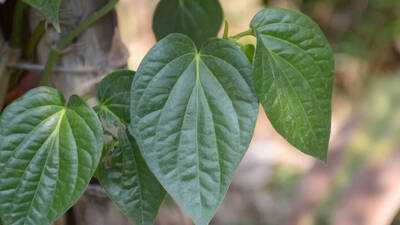7 health benefits of betel leaves: How they support blood sugar levels, oral health, liver protection, and more
ETimes | November 10, 2025 10:39 AM CST

Betel leaves have held a cherished place in cultural traditions and daily life across Asia for centuries. Recognised for their distinctive aroma, glossy green appearance, and versatile uses, they are often associated with rituals, hospitality, and symbolism. Beyond their cultural and social significance, betel leaves have also been valued in various traditional practices for their refreshing qualities and natural appeal. Their presence in art, literature, and cuisine reflects their deep-rooted connection to heritage and community life. Today, betel leaves continue to be appreciated not only for their historical importance but also for their enduring role as a natural and meaningful element in many aspects of daily living.
From Culture to cure: Why betel leaves remain a symbol of wellness
Betel leaves come from the Piper betle vine, a member of the pepper family. These heart-shaped, glossy green leaves are widely used in rituals, herbal preparations, and as part of the traditional chewing mixture known as “paan.”
It’s important to differentiate between the betel leaf itself and betel quid (which includes areca nut, lime, and sometimes tobacco). The leaf alone has beneficial properties, while the mixture can pose health risks.

Nutritional and bioactive composition of betel leaves
According to , betel leaves are rich in a wide variety of bioactive compounds that contribute to their medicinal value:
This combination makes betel leaves a powerhouse of natural therapeutic agents.
Key health benefits of betel leaves
1. Powerful antioxidant and anti-inflammatory effects
Betel leaves contain high levels of antioxidants that combat oxidative stress, a key factor in ageing and many chronic diseases. Their anti-inflammatory properties help reduce swelling, pain, and tissue irritation, potentially supporting conditions such as arthritis and infections.
2. Supports oral health and hygiene
Traditionally chewed after meals, betel leaves are known to refresh the mouth and maintain oral hygiene. The antibacterial compounds in the leaves inhibit the growth of harmful microbes that cause bad breath, gum inflammation, and tooth decay. Regular use of betel leaf extracts in mouth rinses may promote healthier gums and fresher breath.
3. Promotes healthy digestion
Chewing or consuming betel leaves after meals stimulates saliva secretion, aiding the breakdown of food and promoting smooth digestion. They help relieve issues like bloating, indigestion, and constipation. Studies suggest that betel leaf extracts may protect the stomach lining, enhance mucus production, and prevent the formation of ulcers.
4. Regulates blood sugar and metabolic health
Research indicates that compounds in betel leaves may help regulate blood glucose levels and improve insulin sensitivity. Their antioxidant and anti-inflammatory actions support overall metabolic health, potentially lowering the risk of diabetes and related complications.
5. Liver, heart, and brain protection
Betel leaves have shown potential in supporting vital organs:
6. Antimicrobial and wound-healing properties
Betel leaves possess strong antimicrobial and antifungal properties, making them effective against a range of pathogens. Traditionally, crushed betel leaves are applied to wounds, burns, and insect bites to promote faster healing and reduce the risk of infection. The leaf’s natural compounds also support skin regeneration and recovery.
Traditional uses vs. Modern science
In traditional Ayurvedic medicine, betel leaves have been used to treat cough, cold, bronchitis, headaches, infections, and digestive disorders. Modern research confirms many of these benefits, highlighting their antioxidant, antimicrobial, and anti-inflammatory actions.
While promising, most scientific studies are pre-clinical, and more human-based research is needed to confirm their full potential.
Practical uses and consumption of betel leaves
Disclaimer: This article is for informational purposes only and should not be considered medical advice. Please consult a healthcare professional before making any changes to your diet, medication, or lifestyle.
Also read |
From Culture to cure: Why betel leaves remain a symbol of wellness
Betel leaves come from the Piper betle vine, a member of the pepper family. These heart-shaped, glossy green leaves are widely used in rituals, herbal preparations, and as part of the traditional chewing mixture known as “paan.”
It’s important to differentiate between the betel leaf itself and betel quid (which includes areca nut, lime, and sometimes tobacco). The leaf alone has beneficial properties, while the mixture can pose health risks.

Nutritional and bioactive composition of betel leaves
According to , betel leaves are rich in a wide variety of bioactive compounds that contribute to their medicinal value:
- Polyphenols and flavonoids provide antioxidant and anti-inflammatory benefits.
- Essential oils and terpenes such as eugenol, chavibetol, and cineole offer antimicrobial and digestive properties.
- Micronutrients, including small amounts of protein, fibre, vitamin C, and carotenoids, support immunity and tissue repair.
This combination makes betel leaves a powerhouse of natural therapeutic agents.
Key health benefits of betel leaves
1. Powerful antioxidant and anti-inflammatory effects
Betel leaves contain high levels of antioxidants that combat oxidative stress, a key factor in ageing and many chronic diseases. Their anti-inflammatory properties help reduce swelling, pain, and tissue irritation, potentially supporting conditions such as arthritis and infections.
2. Supports oral health and hygiene
Traditionally chewed after meals, betel leaves are known to refresh the mouth and maintain oral hygiene. The antibacterial compounds in the leaves inhibit the growth of harmful microbes that cause bad breath, gum inflammation, and tooth decay. Regular use of betel leaf extracts in mouth rinses may promote healthier gums and fresher breath.
3. Promotes healthy digestion
Chewing or consuming betel leaves after meals stimulates saliva secretion, aiding the breakdown of food and promoting smooth digestion. They help relieve issues like bloating, indigestion, and constipation. Studies suggest that betel leaf extracts may protect the stomach lining, enhance mucus production, and prevent the formation of ulcers.
4. Regulates blood sugar and metabolic health
Research indicates that compounds in betel leaves may help regulate blood glucose levels and improve insulin sensitivity. Their antioxidant and anti-inflammatory actions support overall metabolic health, potentially lowering the risk of diabetes and related complications.
5. Liver, heart, and brain protection
Betel leaves have shown potential in supporting vital organs:
- Liver protection: They may aid detoxification and help the liver recover from oxidative damage.
- Heart health: By helping regulate cholesterol and lipid levels, betel leaves could support cardiovascular well-being.
- Brain protection: Their antioxidant compounds may protect brain cells from damage and support cognitive function.
6. Antimicrobial and wound-healing properties
Betel leaves possess strong antimicrobial and antifungal properties, making them effective against a range of pathogens. Traditionally, crushed betel leaves are applied to wounds, burns, and insect bites to promote faster healing and reduce the risk of infection. The leaf’s natural compounds also support skin regeneration and recovery.
Traditional uses vs. Modern science
In traditional Ayurvedic medicine, betel leaves have been used to treat cough, cold, bronchitis, headaches, infections, and digestive disorders. Modern research confirms many of these benefits, highlighting their antioxidant, antimicrobial, and anti-inflammatory actions.
While promising, most scientific studies are pre-clinical, and more human-based research is needed to confirm their full potential.
Practical uses and consumption of betel leaves
- Fresh leaf chew: Consumed after meals to aid digestion and freshen breath.
- Herbal tea or extract: Can be brewed as a tea or used in herbal formulations for digestive or antimicrobial benefits.
- Topical application: Crushed leaves can be applied directly to wounds, rashes, or insect bites to relieve irritation and promote healing.
- Avoid additives: The health benefits apply to the betel leaf alone; combining it with areca nut or tobacco negates its positive effects and increases health risks.
Disclaimer: This article is for informational purposes only and should not be considered medical advice. Please consult a healthcare professional before making any changes to your diet, medication, or lifestyle.
Also read |
READ NEXT
-
Himanta: Rising minority affluence may signal ‘Assamese surrender’

-
Hashim Amla Reveals His Toughest Opponent In IPL History

-
Cockroaches are secretly polluting your indoor air: Why pest control matters for clean and healthy homes

-
The Big Ultrasound: What You'll Learn About Baby This Week

-
5 Mysteries of Mount Kailash That Science Still Can't Explain
